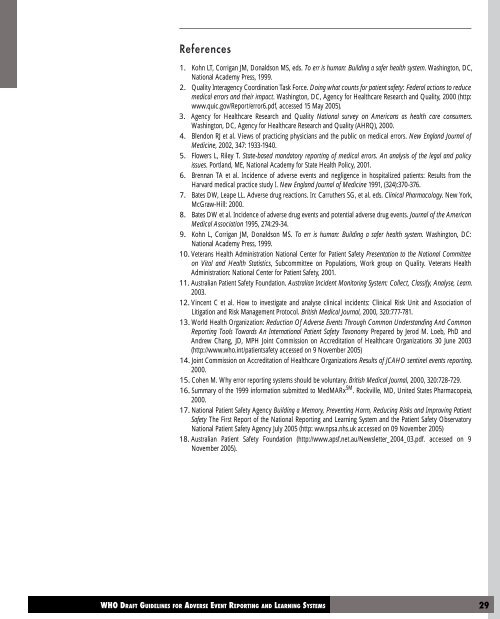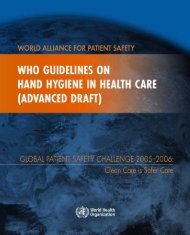Adverse event reporting.pdf
Adverse event reporting.pdf
Adverse event reporting.pdf
Create successful ePaper yourself
Turn your PDF publications into a flip-book with our unique Google optimized e-Paper software.
References<br />
1. Kohn LT, Corrigan JM, Donaldson MS, eds. To err is human: Building a safer health system. Washington, DC,<br />
National Academy Press, 1999.<br />
2. Quality Interagency Coordination Task Force. Doing what counts for patient safety: Federal actions to reduce<br />
medical errors and their impact. Washington, DC, Agency for Healthcare Research and Quality, 2000 (http:<br />
www.quic.gov/Report/error6.<strong>pdf</strong>, accessed 15 May 2005).<br />
3. Agency for Healthcare Research and Quality National survey on Americans as health care consumers.<br />
Washington, DC, Agency for Healthcare Research and Quality (AHRQ), 2000.<br />
4. Blendon RJ et al. Views of practicing physicians and the public on medical errors. New England Journal of<br />
Medicine, 2002, 347: 1933-1940.<br />
5. Flowers L, Riley T. State-based mandatory <strong>reporting</strong> of medical errors. An analysis of the legal and policy<br />
issues. Portland, ME, National Academy for State Health Policy, 2001.<br />
6. Brennan TA et al. Incidence of adverse <strong>event</strong>s and negligence in hospitalized patients: Results from the<br />
Harvard medical practice study I. New England Journal of Medicine 1991, (324):370-376.<br />
7. Bates DW, Leape LL. <strong>Adverse</strong> drug reactions. In: Carruthers SG, et al. eds. Clinical Pharmacology. New York,<br />
McGraw-Hill: 2000.<br />
8. Bates DW et al. Incidence of adverse drug <strong>event</strong>s and potential adverse drug <strong>event</strong>s. Journal of the American<br />
Medical Association 1995, 274:29-34.<br />
9. Kohn L, Corrigan JM, Donaldson MS. To err is human: Building a safer health system. Washington, DC:<br />
National Academy Press, 1999.<br />
10. Veterans Health Administration National Center for Patient Safety Presentation to the National Committee<br />
on Vital and Health Statistics, Subcommittee on Populations, Work group on Quality. Veterans Health<br />
Administration: National Center for Patient Safety, 2001.<br />
11. Australian Patient Safety Foundation. Australian Incident Monitoring System: Collect, Classify, Analyse, Learn.<br />
2003.<br />
12. Vincent C et al. How to investigate and analyse clinical incidents: Clinical Risk Unit and Association of<br />
Litigation and Risk Management Protocol. British Medical Journal, 2000, 320:777-781.<br />
13. World Health Organization: Reduction Of <strong>Adverse</strong> Events Through Common Understanding And Common<br />
Reporting Tools Towards An International Patient Safety Taxonomy Prepared by Jerod M. Loeb, PhD and<br />
Andrew Chang, JD, MPH Joint Commission on Accreditation of Healthcare Organizations 30 June 2003<br />
(http://www.who.int/patientsafety accessed on 9 November 2005)<br />
14. Joint Commission on Accreditation of Healthcare Organizations Results of JCAHO sentinel <strong>event</strong>s <strong>reporting</strong>.<br />
2000.<br />
15. Cohen M. Why error <strong>reporting</strong> systems should be voluntary. British Medical Journal, 2000, 320:728-729.<br />
16. Summary of the 1999 information submitted to MedMARx SM . Rockville, MD, United States Pharmacopeia,<br />
2000.<br />
17. National Patient Safety Agency Building a Memory, Pr<strong>event</strong>ing Harm, Reducing Risks and Improving Patient<br />
Safety The First Report of the National Reporting and Learning System and the Patient Safety Observatory<br />
National Patient Safety Agency July 2005 (http: ww.npsa.nhs.uk accessed on 09 November 2005)<br />
18. Australian Patient Safety Foundation (http://www.apsf.net.au/Newsletter_2004_03.<strong>pdf</strong>. accessed on 9<br />
November 2005).
















